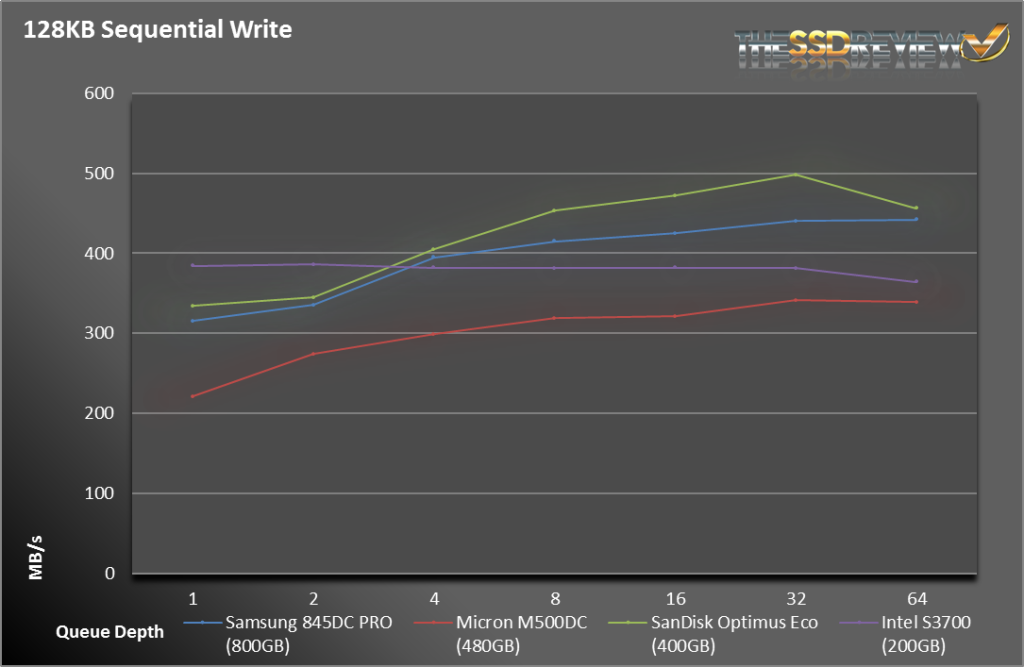MEASURING PERFORMANCE
As with all of our tests, the following tests were performed after a secure erase of the drive. The drive was also conditioned with a predefined workload until it reached steady state. We also test across the entire span of the drive.
When it comes to sequential operations, the 845DC PRO doesn’t blow away the competition. It comes out in the middle of the pack, not quite able to top the SanDisk Optimus Eco. With that said, it does post very good results, topping 500MB/s for read operations and almost 450MB/s for writes.
The 845DC PRO continues its random write dominance, keeping a large lead across all queue depths. We really can’t say it enough, but the 4KB random write performance is not just class leading, it’s class leading by a solid 25%. The ability of Samsung’s 3D V-NAND is just astounding.
Read performance is also excellent, though not nearly as impressive as the write performance. We had no issues hitting 90K IOPS. Although we don’t show it, the 845DC PRO’s read performance lines up very closely to the Samsung 845DC EVO. In fact, the PRO does everything the EVO does, only better. While the EVO is targeting read-focused applications, the PRO is able to handle heavy write workloads as well.
Although the majority of the testing was performed on our 800GB sample, we also got a good look at the 400GB model. On paper, the two capacities have almost identical performance. In practice, we see very little variation.
For write operations, we see slightly more than the 1K IOPS difference at higher queue depths. For a single queue depth, the 400GB trailed by a healthy margin, but it still managed almost 30K IOPS. In our read tests, both drives performed almost identically, with the 800GB model having a slight edge at a single queue depth. Considering most enterprise application operate at higher queue depths, you shouldn’t see much difference between the two models.
SNIA IOPS TESTING
The Storage Networking Industry Association has an entire industry accepted performance test specification for solid state storage devices. Some of the tests are complicated to perform, but they allow us to look at some important performance metrics in a standard, objective way.
SNIA’s Performance Test Specification (PTS) includes IOPS testing, but it is much more comprehensive than just running 4KB writes with IOMeter. SNIA testing is more like a marathon than a sprint. In total, there are 25 rounds of tests, each lasting 56 minutes. Each round consists of 8 different block sizes (512 bytes through 1MB) and 7 different access patterns (100% reads to 100% writes). After 25 rounds are finished (just a bit longer than 23 hours), we record the average performance of 4 rounds after we enter steady state.
- Preconditioning: 3x capacity fill with 128K sequential writes
- Each round is composed of .5K, 4K, 8K, 16K, 32K, 64K, 128K, and 1MB accesses
- Each access size is run at 100%, 95%, 65%, 50%, 35%, 5%, and 0% Read/Write Mixes, each for one minute.
- The test is composed of 25 rounds (one round takes 56 minutes, 25 rounds = 1,400 minutes)
Our SNIA testing showed us a lot of what we already know, which is that the 845DC PRO is a great SSD. We easily hit 50/90K IOPS for 4KB writes/reads. We also saw good scaling in the mixed read/write tests. We didn’t see any significant dips between the extremes, showing that the 845DC PRO was able to handle mixed workloads without compromising performance.
 The SSD Review The Worlds Dedicated SSD Education and Review Resource |
The SSD Review The Worlds Dedicated SSD Education and Review Resource | 


There seem to be two errors in the images for the “Fileserver profile” and the “Webserver profile”. The names in those charts tell me that those results are for the 845DC EVO and not the 845DC PRO.
The “Fileserver profile” result looks like a typo (result is better then in the actual 845DC EVO test so this seems to be the 845DC PRO result).
The result of the “Webserver profile” looks pretty much exactly as the 845DC EVO result. Maybe there is indeed no difference to speak of in this test scenario.
For the wishlist: A direct comparison of the 845DC PRO and the 845DC EVO would be nice. 🙂
In general the new 845DC PRO looks nice but it’s way to expensive when you compare it against the price range of the consumer versions including let’s say a +25-50% price tag for the DataCenter SSD.
Internally there is not that much different except for the obvious (DataCenter SSD: better/optimized Firmware, lower clocked Controller, less packed/layered 3D NAND, [better/more] Capacitors).
The price for the Intel DC S3700 and SanDisk Optimus EVO [SAS instead of SATA-Interface] is the same in Germany for the 400 GB version (on the 800 GB version the Intel is more expensive).
So if I would have to decide (incl. the 845DC PRO) I would get the SanDisk (cheaper and better performance in most usecases) as long as the Samsung is more expensive.
I’m currently about to buy several DataCenter SSDs for my “HomeServer” (Database/DWH, OLAP; SAS RAID-Cache Controller with BBU; planned a RAID-6). Currently it seems I might actually try the 845DC EVO. The money I save for other SSD options will go into additional memory modules.
“All of this performance is for not…”
“Naught”, not “not”.
The 845DC Pro is just a new name for an existing drive. SV843 is exactly the same drive (just using 7% OP instead of 28% OP),… and SV843 is much cheaper! If you change values to 28% on the SV843 you’ll get the same performance as 845DC. Same like 845DC EVO = PM853T. Both products are just sold by 2 different operations (Electronis and Semiconductor) Cheers